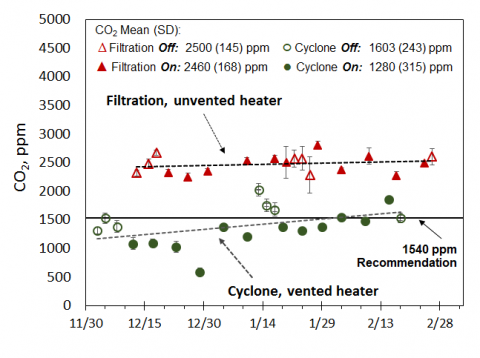Assessment of Interventions to Improve Air Quality in a Livestock Building
T. Renée Anthony, Anthony Yang, Thomas M. Peters
Journal of Agricultural Health and Safety, 23(4): 247-263 (2017)
ABSTRACT:
This study examined the effectiveness of engineering controls to reduce contaminant concentrations in a swine farrowing room during winter in the U.S. Midwest. Over two winters, changes in air quality were evaluated following installation of a 1700 m3 h-1 (1000 cfm) recirculating ventilation system to provide 5.4 air exchanges per hour. This system incorporated one of two readily available dust control systems, one based on filtration and the other on cyclonic treatment. A second treatment evaluated reductions in carbon dioxide (CO2) associated with replacement of standard, unvented gas-fired heaters with new vented heaters, installed between the two winter test periods. The concentrations of carbon monoxide and hydrogen sulfide were negligible in the test room. Although concentrations of ammonia increased over each winter test period, the increase was unrelated to increased air movement from the new recirculating ventilation system. The dust concentrations were significantly reduced by the ventilation system for both inhalable dust (23% to 44% with filtration, 33% with cyclone) and respirable dust (32% with filtration, 20% with cyclone), significant (p < 0.024) for all except respirable dust using the cyclone (p = 0.141). The filtration unit is recommended to improve livestock building air quality because it was more effective than the cyclone unit at reducing respirable dust. Carbon dioxide concentrations were significantly lower with vented heaters (mean = 1400 ppm, SD = 330 ppm) compared to unvented heaters (mean = 2480 ppm, SD = 160 ppm). A 940 ppm reduction in CO2 was attributed to the use of the vented heater, after accounting for differences in outdoor temperatures and animal housing over both test periods. The benefits of readily available technology to significantly reduce concentrations of dust and CO2 demonstrates useful control options to improve air quality in swine buildings.
Room Layout and Intervention Installation

Carbon Dioxide Differences by Heater

Article: Air Quality Paper in JASH